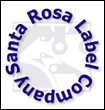

Colors:
If
a lighter shade of a Pantone® color is desired, a % of that color should
be used. You cannot alter the CMYK percent of a Pantone® spot color
and then have it print as a spot color. A gradient of any spot color must
be only ONE color. It cannot be 0% of black and 99% of a spot color. The
computer will automatically convert this image to CMYK. Please use the
Pantone® colors provided in the various software graphics programs.
If you create your own spot colors they will be converted to CMYK by the
computer. The image on a printed page will not match the exact colors on
the finished product. An inkjet color printout should not be used as a
match for colors. The Pantone® swatches are closer in color to the
actual finished product than any printout.
Fonts/Type:
All
printer and screen fonts must be included on the disk with the files. PC
fonts cannot be used in our Macintosh computer, therefore the closest possible
match will be substituted. Type should NEVER be set in Photoshop. It should
only be in Illustrator etc. Type should be over 3 points in size. Type
reversed out of a color should be at least 5 points if not larger, reverse
type should be thicker than regular type. Try to avoid having any symbols
(®©™ etc) reversed as they will 'close up' and not be legible.
Layers:
Layers
can be used in every program except in a Photoshop EPS or TIFFs. It is
a good idea to put all text that is the same color on a layer of its own.
It is not necessary to put every item on it's own layer.
Placed
Images:
All
images that appear on the file and are not created in that file must be
included on the disk. They need to be in EPS or TIFF format. All Photoshop
images must be in either CMYK, grayscale or bitmap mode. RGB is not acceptable
and is converted to CMYK in order to print separations. All images should
be at least 300 dpi if there are any gradations or screens. Lower resolution
Bitmap images are acceptable. A low resolution image in CMYK or grayscale
cannot be improved and will appear grainy. It is never a good idea to create
something in one application and then import it into another with the exception
of Photoshop. If an image can be created in Illustrator it should be left
there and not imported into Quark. It is much easier for flexographic printers
to work in Illustrator and Freehand than Quark. Quark is meant for page
layout projects, not single page items. An image from one application should
never be embedded into a file of another application. This makes the file
larger and more difficult to work with.
Platforms:
Macintosh
or PC format
Software:
Adobe
Illustrator®
Adobe
Photoshop® (for placed images)
Freehand®
Quark® (not recommended)
Files
should be saved uncompressed in either Macintosh or PC format on one of
the
following:
Floppy
disk
ZIP
Disk
Compact
Disk
Syquest
(only if absolutely necessary)
Screens:
A
graduated screen created on a computer should not be 100% to 0% of any
color. 3% to 90% will print more easily. There is always a loss of color
for anything with a screen of 3% or less. A screen of a spot color must
only be 1 color. (See Color section above).
Size:
All
label artwork should have a dieline drawn on the file -NOT from Photoshop.
Lines created in Photoshop and imported into any other program do not appear
clearly on the screen, therefore we cannot accurately place the die line
on the artwork. All copy and art of a label must be at least 1/16" away
from the edge of the label unless there is a bleed of color off the edge
of the label.
Trapping/Bleeds/Registration: Trapping for flexo printing is different than for other types of printing. There always needs to be a trap where two colors meet. If there is a black line on top of where any two colors meet it should be at least 1 point in size, this way it will print on top of the two colors, eliminating the need for a trap. It is best to not trap your artwork, because the guidelines for trapping for flexo printing are more complex than normal. The bleed of any color off the edge of a label should be at least 1/8 of an inch. If there is a border around the label it should be inside the label edge by at least 1/16 of an inch if not more.
UPC:
You
may provide the codes in the files by way of written numbers or the actual
code itself. The number provided must have the Number System Digit, the
5 digit Manufacture Number and the 5 digit product code, in order. The
UPC printing program automatically calculates the last number of the code.
The size recommended by the UPC council is 100%. Any size down to 80% is
acceptable. We will always use 80% and over if possible.
Art Specifications | CMYK | Design Rules | Prepress Terminology | Things to Consider
© Copyright 2000 Santa Rosa Label All Rights Reserved | 707.578.6022